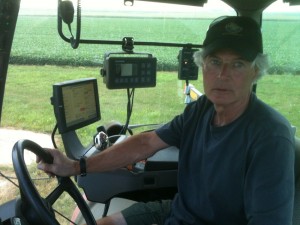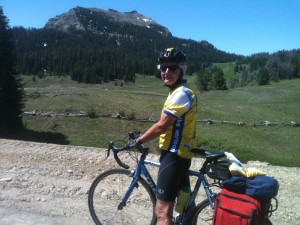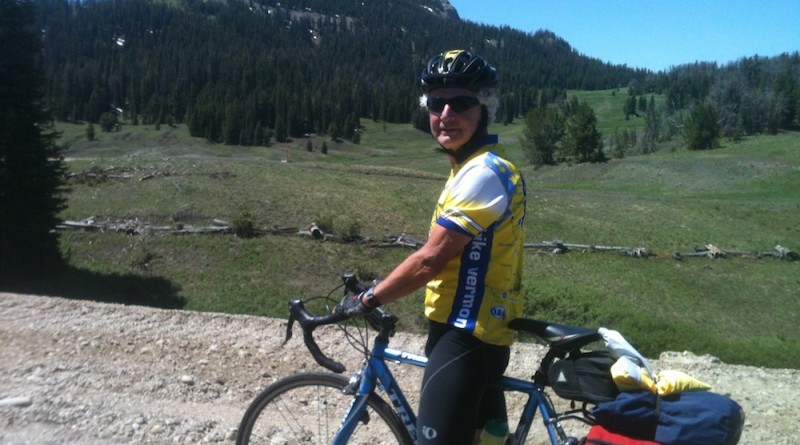Frank Driscoll | Reader Athlete
 Frank Driscoll
Frank Driscoll
Age: 64
Residence: North Hero
Family: Wife, Kathleen; adult children, Keith, Brendan, and Deirdre
Occupation: Consulting Project Manager; part-time tour leader for Discovery Bicycle Tours
Primary sports: Road cycling, running
Having survived bouts with cancer and a total hip replacement, Frank Driscoll got on his Trek 1500 in Seattle on June 17, 2012, and headed east for a solo cross-country ride. Forty-eight days and 3,665 miles later, he arrived in Rye, New Hampshire, with a smile, it seems, that hasn’t left his face since.
VS: When did you decide you wanted to do a cross-country bike ride?
FD: I’ve wanted to do this ride for 10 to 15 years. In the last five years, I had two cancers and a hip replacement, which caused no changes in my lifestyle whatsoever, but in fall of 2011, I had several friends suffer strokes and heart attacks, and I decided, “If not now, when?”
VS: Tell us about your journey.
FD: I still smile when I think about it. A day doesn’t go by that I don’t think about someone I met or a road I cycled on. It was just unbelievable. It started out as a bike ride, and on day three in Yakima, it became 50 percent bike ride and 50 percent unbelievable people experience. I didn’t camp so I was able to travel light. In addition to the bike, I carried 46 pounds consisting of two pairs of riding apparel, minimal clothing to wear when I stopped at night, chains, tubes, tires, spokes, tools, and cables. I mapped out the entire route in advance, but I started changing it depending on who I had dinner with the night before or met at the bar, so I only made reservations a day or two in advance. Sometimes I would change my plans and ride an extra 20 miles if a place didn’t look that good. O’Neill, Nebraska, was high on my list (O’Neill is called the Irish capital of Nebraska), but when I got there, I saw the hotel was in the middle of the busiest intersection in northern Nebraska so I canceled my reservation; and even though it had to be 100 degrees, I continued on to Orchard, Nebraska, where I had my first conversation with a member of the Amish sect.
VS: What was the high point of the ride?
FD: There were a ton of high points. I rode during the hottest summer on record, which didn’t detract at all from me feeling euphoric. I’ve got to say that most every day getting on the bike, heading on the road, and going somewhere different and new had me smiling. From a people perspective, Jackson, Wyoming, was over the top. I’m a member of the Warm Showers Community (a free worldwide hospitality exchange for touring cyclists), and I stayed with five Warm Showers hosts. In Jackson, I got a text in the afternoon from a host saying she was going out for a ride and she would leave the door unlocked. When she got home, she invited me to a dinner party across town where we sat on the deck overlooking the elk refuge. Those kinds of experiences happened over and over again. The best ride was climbing the hill out of Kennewick, Washington. I went uphill seven miles and then downhill 12 miles without braking to the Columbia River. It was beautiful.
VS: What was your toughest day?
FD: Going from Shoshone to Casper, Wyoming—98 miles on a 100-degree day. It was absolutely the most barren landscape I’ve ever seen, and very hilly. I had a 20-mph head wind the whole day. It was a wonderful experience, but a really hard ride. My first place to stop was at 46 miles, and the lady at the store said severe thunderstorms were predicted in an hour. The sky only broke wide open as I rode into Casper so I felt like I had a four-leaf clover on my back.
VS: Did you have a lot climbing on the ride?
FD: I went over the Tetons, the Cascades, and the Blue Mountains. I didn’t realize how hard those were; they’re almost as steep as the Tetons. I also climbed over the Continental Divide and went through Pine Creek, Idaho. Some of the toughest riding was across New York State just south of the Finger Lakes. From Aurora to Cazenovia there are 10 to 12 percent drops and then 10 to 11 percent rises, up and down, up and down. It was tough because I didn’t expect it. Over Route 9 in the Green Mountains was tough, but by then, I was in pretty good shape.
 VS: Was there ever a time that you wanted to quit?
VS: Was there ever a time that you wanted to quit?
FD: I never gave it a thought. I had very few bad experiences. I had one accident going down Teton Pass. I had expected to see lots of riders, but I didn’t. I met one cyclist going up and rode with her for a while. Some people at the top convinced us to take the old road down into Wilson instead of the main road. I didn’t want to but I did, and I hit a piece of bad pavement and had a blowout and a bad accident. Other than that, thanks to steel-belted tires, I didn’t have a single flat. I started every day expecting the sun to shine, but on day two, it was absolutely pouring rain. I debated whether to stay in the hotel all day, but I put on my rain gear and rode the hard-packed gravel Iron Horse Trail over the Cascades. I got soaking wet, but it was beautiful scenery. Once I got over the fact that I was wet, it was a nice day.
VS: Have you always been a cyclist?
FD: I’ve always been a runner and a cyclist. I have very fond memories of my best Christmas present: a three-speed Raleigh I got when I was 7 years old. My entire life I’ve ridden at some level. I started running in ninth grade and never stopped. I was on the board of RunVermont for several years, and I still run twice a week, although emotionally, it was tough to get back into running after my hip replacement.
VS: Do you have a favorite local cycling route?
FD: Even though I live in a flat area, I like to ride hills. I love riding in Canada. There’s a great route that includes Highgate, Franklin, and the Morse’s Line border crossing that I love to do.
VS: How did you train for the cross-county ride?
FD: I rode on my trainer during the winter, and I did a lot of mountain bike riding in the spring because I was doing a project in Montpelier. I did a lot of research about how others trained and prepared. The two weeks before the ride, I did two regimens. The first week, I rode 50 miles three days in a row, and the next week, I did it four days in a row. Earlier in the year, I did a 10-day trek in the Andes so that was my altitude training.
VS: Tell us about leading tours for Discovery Bicycle Tours.
FD: It’s really enjoyable. I love Vermont, and I get to show people around and experience riding with people who are just leisure cyclists and get to encourage them. It’s taught me to slow down a little and enjoy the ride.


